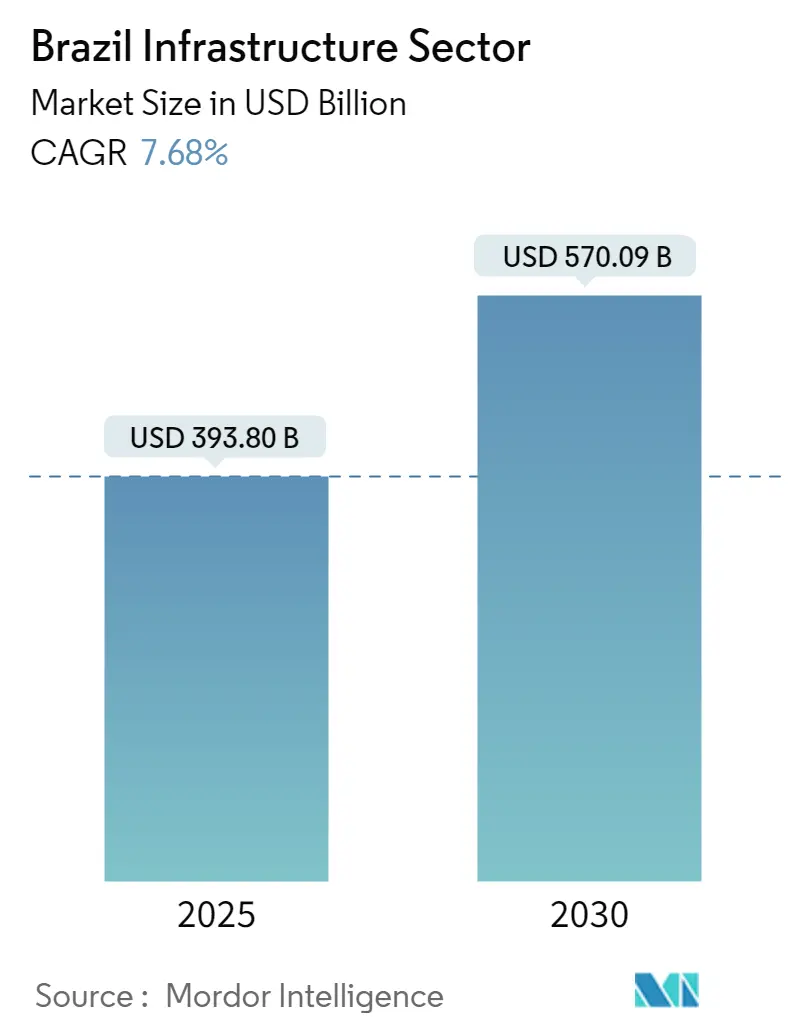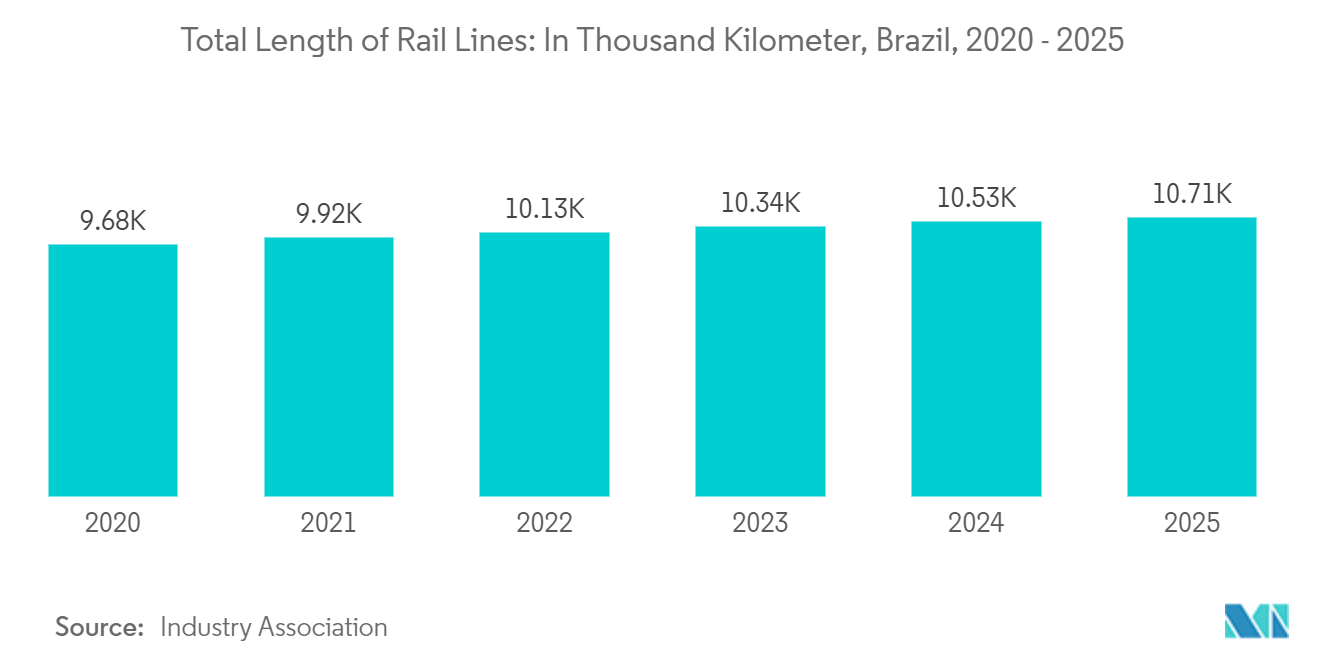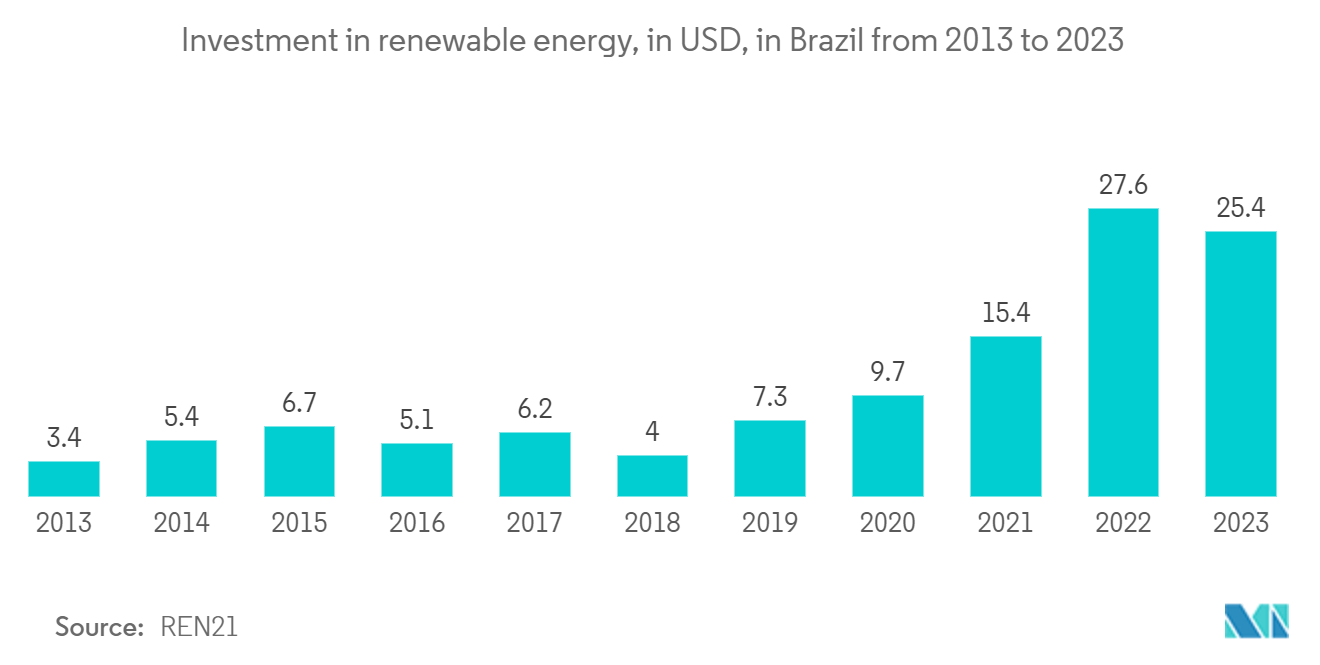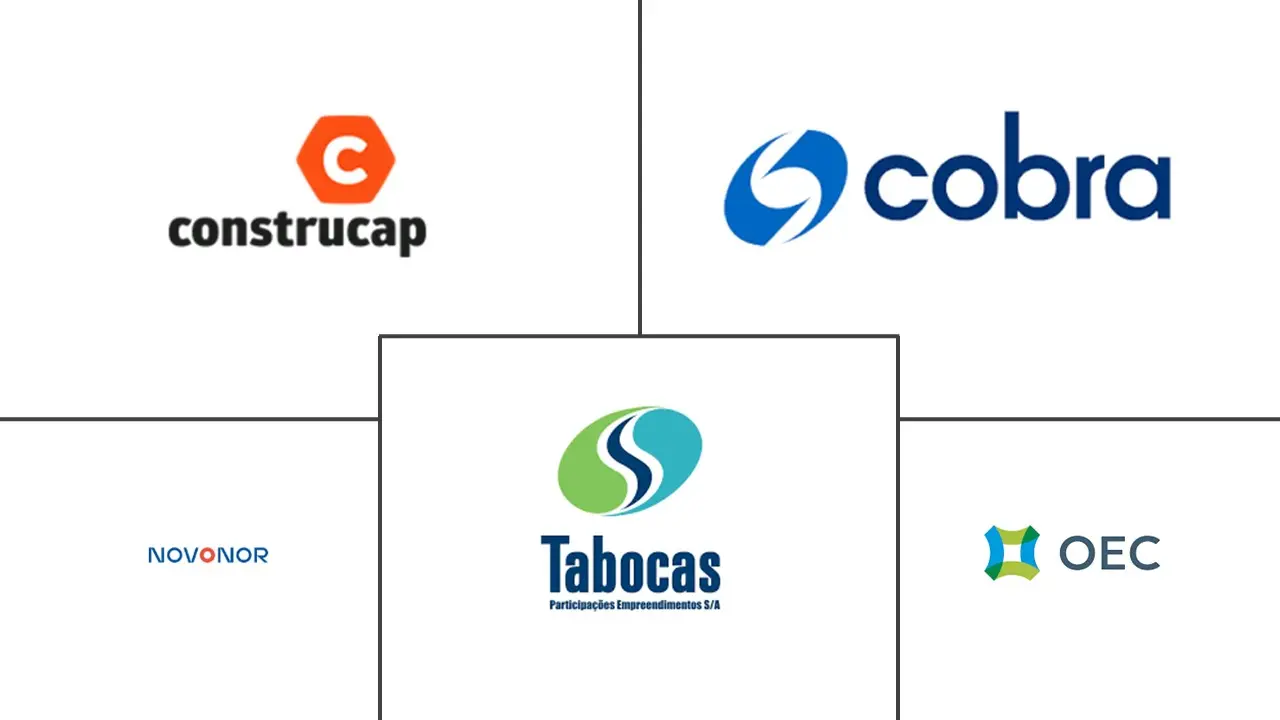
Brazil Infrastructure Sector Market Analysis
The Brazil Infrastructure Market size is estimated at USD 393.80 billion in 2025, and is expected to reach USD 570.09 billion by 2030, at a CAGR of 7.68% during the forecast period (2025-2030).
- Brazil's infrastructure market is undergoing a significant transformation, especially with the emergence of the green economy. While sectors like renewable energy are reaching maturity, others, including green hydrogen and carbon markets, need focused efforts to scale. Public-private partnerships (PPPs) are set to be pivotal in propelling these initiatives forward.
- Furthermore, collaborations between private entities, through joint ventures and mergers, will be vital for advancing new infrastructure projects in green energy. The success of Brazil's transition hinges on concerted efforts from both the government and the private sector, championing eco-ambitions and ensuring effective execution, all while aiming for sustainable and inclusive growth.
- Brazil's renewable energy infrastructure positions it as a potential global leader in green hydrogen production, bolstered by low energy production costs and an integrated power grid. The nation's rich biomass resources, such as sugarcane residues and unique crops like macaúba, pave the way for biofuels, biomethane, and sustainable fuel production. Projections as reported by the industry association suggests that by 2040, Brazil could access a sustainable fuels market valued at up to USD 40 billion, all while maintaining its agricultural output.
- Brazil Infrastructure Company (BIC) has embarked on a mission to transform Brazil's telecommunications landscape. With a focus on developing tailored digital assets, BIC seeks to close connectivity gaps, particularly in suburban and rural regions. This effort aligns with the urban network enhancements undertaken by leading telecom operators such as Vivo, TIM, and Claro, broadening digital access for marginalized communities.
Brazil Infrastructure Sector Market Trends
Key Cities Driving Developments in the Market
- In 2024, key cities like São Paulo, Rio de Janeiro, and Salvador are driving Brazil's infrastructure market, each spearheading ambitious urban enhancement projects. Leading the charge, São Paulo, Brazil's largest city, is pushing forward with its metro expansion. The Governor of São Paulo has inked a contract for the metro's extension to Jardim Ângela. With a hefty investment of BRL 3.4 billion (USD 700 million), the project is set to extend Line 5-Lilac by an additional 4.3 km, introducing 2 new stations and pushing the service further south, as reported by RailwayPro in June 2024. Furthermore, the Metro's ongoing works span 43 kilometers and 19 stations, backed by a substantial investment of BRL 23 billion (USD 4.19 billion) for expansion, as highlighted by RailwayPro in September 2024. This metro expansion aims to bolster urban mobility and alleviate traffic woes in a city where over 70% of residents depend on public transport.
- These key cities are reaping the benefits of government initiatives designed to lure foreign investments into infrastructure. As per the data provided by the World Bank Group in April 2024, the World Bank has injected a significant USD 650 million into the infrastructure, funding 26 new trains, signaling gear, and platform doors across all stations. Complementing this, the Inter-American Development Bank (IDB) has provided a loan of USD 367.1 million. Additionally, ViaMobilidade, a private entity, has clinched a 20-year concession (valid until 2038) to operate the line, pledging an investment of 88 million reais for upgrades and enhancements.
- In summary, key cities like, São Paulo and Rio de Janeiro stand at the forefront of Brazil's infrastructure evolution in 2024. With their ambitious transportation projects, these cities are not just enhancing Brazil's infrastructure but are also shaping the nation's urban living and economic trajectory.

Brazil's Biomass Energy: Infrastructure and Market Potential
- Brazil's infrastructure market is witnessing a pivotal shift, underscored by the nation's increasing emphasis on biomass energy. As Brazil emerges as a frontrunner in the biomass sector, especially in exporting biomass pellets, the infrastructure to bolster this growth becomes paramount. Biomass constitutes nearly 10% of Brazil's total energy production, a figure that significantly overshadows the global average of under 3%, as reported by industry association. This prominence underscores biomass's integral role in Brazil's energy and industrial landscape, especially in sectors like agro-processing, textiles, food production, chemicals, and metals, where it's predominantly harnessed for steam generation.
- With an eye on maximizing its biomass potential, Brazil is channeling efforts into infrastructure projects tailored for biomass exports. Positioned advantageously, Brazil eyes markets like Europe, which is witnessing a surge in demand for renewable heating and power. Yet, a significant challenge looms: the logistics of transporting biomass from production sites to ports. While Brazil boasts substantial biomass capacity, factors like land constraints, competing agricultural demands, and sustainability regulations pose challenges to scaling production. Moreover, bolstering transportation and port facilities is essential for the seamless export of biomass pellets.
- Recent infrastructure initiatives have zeroed in on refining the logistical framework, with the dual aim of streamlining biomass production and distribution. Technological strides, particularly in high-temperature heat applications, open doors to broaden biomass's reach beyond its conventional sectors. Yet, the path isn't without obstacles: unless there's a technological breakthrough or a reevaluation of land use, supply constraints might stymie production growth. Nevertheless, Brazil's seasoned expertise in industrial biomass utilization, coupled with its commitment to sustainable energy infrastructure, positions it as a pivotal player in the global decarbonization narrative.
- In conclusion, Brazil's strategic focus on enhancing its biomass infrastructure not only strengthens its position in the global biomass market but also contributes significantly to global sustainability efforts. By addressing logistical and technological challenges, Brazil can fully leverage its biomass potential, driving both economic growth and environmental benefits.

Brazil Infrastructure Sector Industry Overview
The market is fragmented and is expected to grow during the forecast period due to private and venture capital investment. Some of the major players in the market include OEC, Construtora Queiroz Galvão,Andrade Gutierrez, COBRA Group, Camargo Corrêa Infra Construções, etc.
For instance, OEC in 2019, while constructing Cedae's Novo Marapicu Reservoir, a pivotal project aimed at securing water supply for over three million residents in Rio de Janeiro, utilized Building Information Modeling (BIM) technology. This technology enhanced the project's efficiency and quality, reflecting a forward-thinking approach in Brazil's infrastructure sector.
Brazil Infrastructure Sector Market Leaders
-
OEC
-
COBRA Group
-
Tabocas
-
Novonor
-
Construcap
- *Disclaimer: Major Players sorted in no particular order
Brazil Infrastructure Sector Market News
- January 2024: Valued at USD 125.8 million, the Itajaí Underwater Tunnel project aims to connect the cities of Itajaí and Navegante's in Santa Catarina. Beyond just vehicle lanes, the tunnel will also cater to cyclists and pedestrians, highlighting a commitment to both mobility and sustainability. Construction kicked off in January 2024, with an anticipated completion date set for 2028. Leading this significant endeavor is OEC Engen-Haria, a key player in Brazil's infrastructure landscape.
- May 2024: In May 2024, 3R Petroleum and Enauta merged to create Brava Energia, making it Brazil's second-largest oil producer. This merger aligns with a wider trend in Brazil's energy and infrastructure sectors, emphasizing enhanced efficiency and optimized production. The focus is on leveraging expanded oil reserves and modernizing infrastructure, including pipelines and storage facilities.
Brazil Infrastructure Sector Industry Segmentation
Infrastructure serves as the backbone for both domestic and international commerce, as well as for industrial and agricultural production. It provides the essential organizational and physical framework that enables firms to operate successfully. At its core, basic infrastructure whether within an organization or a nation, encompasses communication and transportation systems, sewage and water management, health and education services, access to safe drinking water, and a robust monetary system.
The infrastructure sector in brazil is segmented by type (Social Infrastructure , Transportation Infrastructure , Extraction Infrastructure, Utilities Infrastructure , Manufacturing Infrastructure) and Key Cities (Sao Paulo, Rio De Janeiro, and Salvador). and key cities (Sao Paulo, Rio de Janeiro, and Salvador). The report offers the market sizes and forecasts for the market in value (USD) for all the above segments.
| By Type | Social Infrastructure |
| Transportation Infrastructure | |
| Extraction Infrastructure | |
| Manufacturing Infrastructure | |
| Utilities Infrastructure | |
| By Key Cities | Sao Paulo |
| Rio de Janeiro | |
| Salvador |
Brazil Infrastructure Sector Market Research FAQs
How big is the Brazil Infrastructure Market?
The Brazil Infrastructure Market size is expected to reach USD 393.80 billion in 2025 and grow at a CAGR of 7.68% to reach USD 570.09 billion by 2030.
What is the current Brazil Infrastructure Market size?
In 2025, the Brazil Infrastructure Market size is expected to reach USD 393.80 billion.
Who are the key players in Brazil Infrastructure Market?
OEC, COBRA Group, Tabocas, Novonor and Construcap are the major companies operating in the Brazil Infrastructure Market.
What years does this Brazil Infrastructure Market cover, and what was the market size in 2024?
In 2024, the Brazil Infrastructure Market size was estimated at USD 363.56 billion. The report covers the Brazil Infrastructure Market historical market size for years: 2020, 2021, 2022, 2023 and 2024. The report also forecasts the Brazil Infrastructure Market size for years: 2025, 2026, 2027, 2028, 2029 and 2030.
Our Best Selling Reports
Brazil Infrastructure Sector Industry Report
Statistics for the 2025 Brazil Infrastructure Sector market share, size and revenue growth rate, created by Mordor Intelligence™ Industry Reports. Brazil Infrastructure Sector analysis includes a market forecast outlook for 2025 to 2030 and historical overview. Get a sample of this industry analysis as a free report PDF download.




